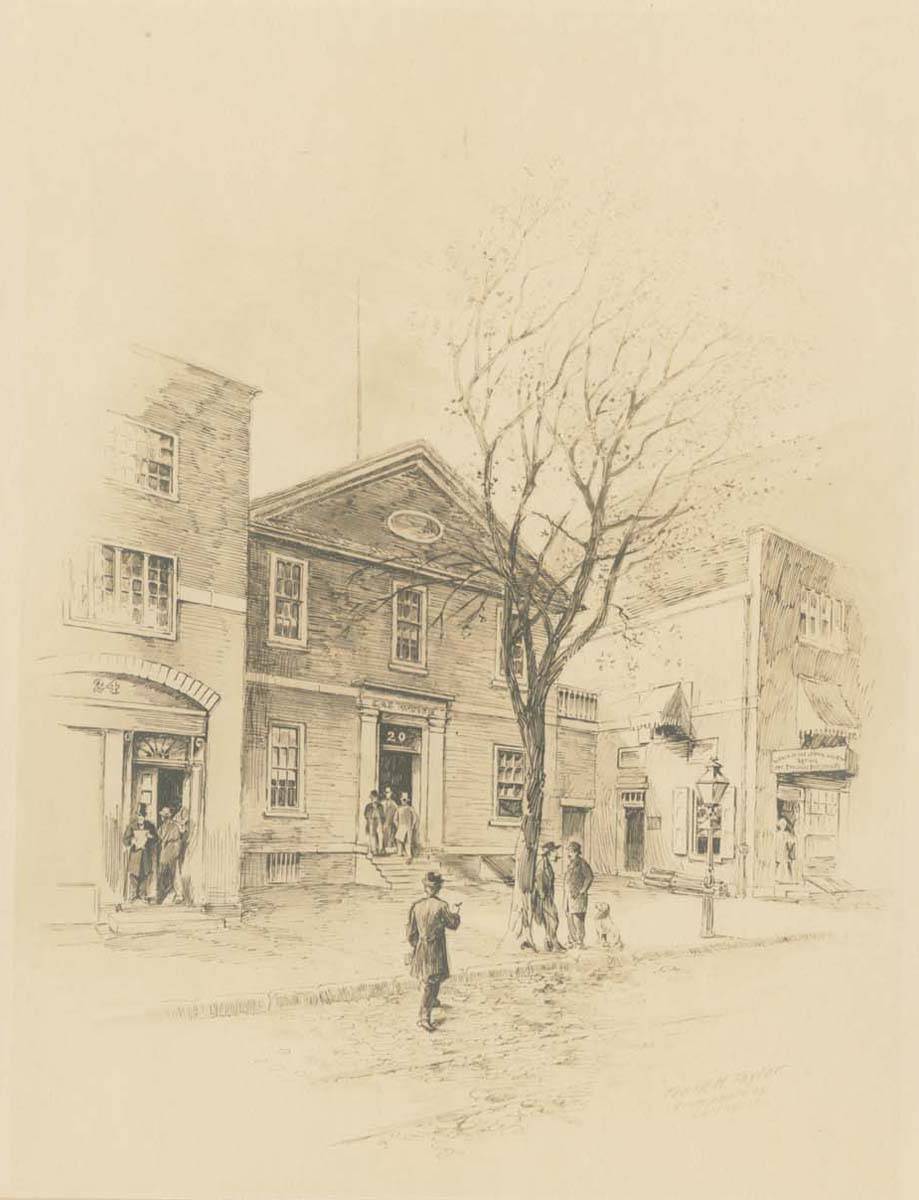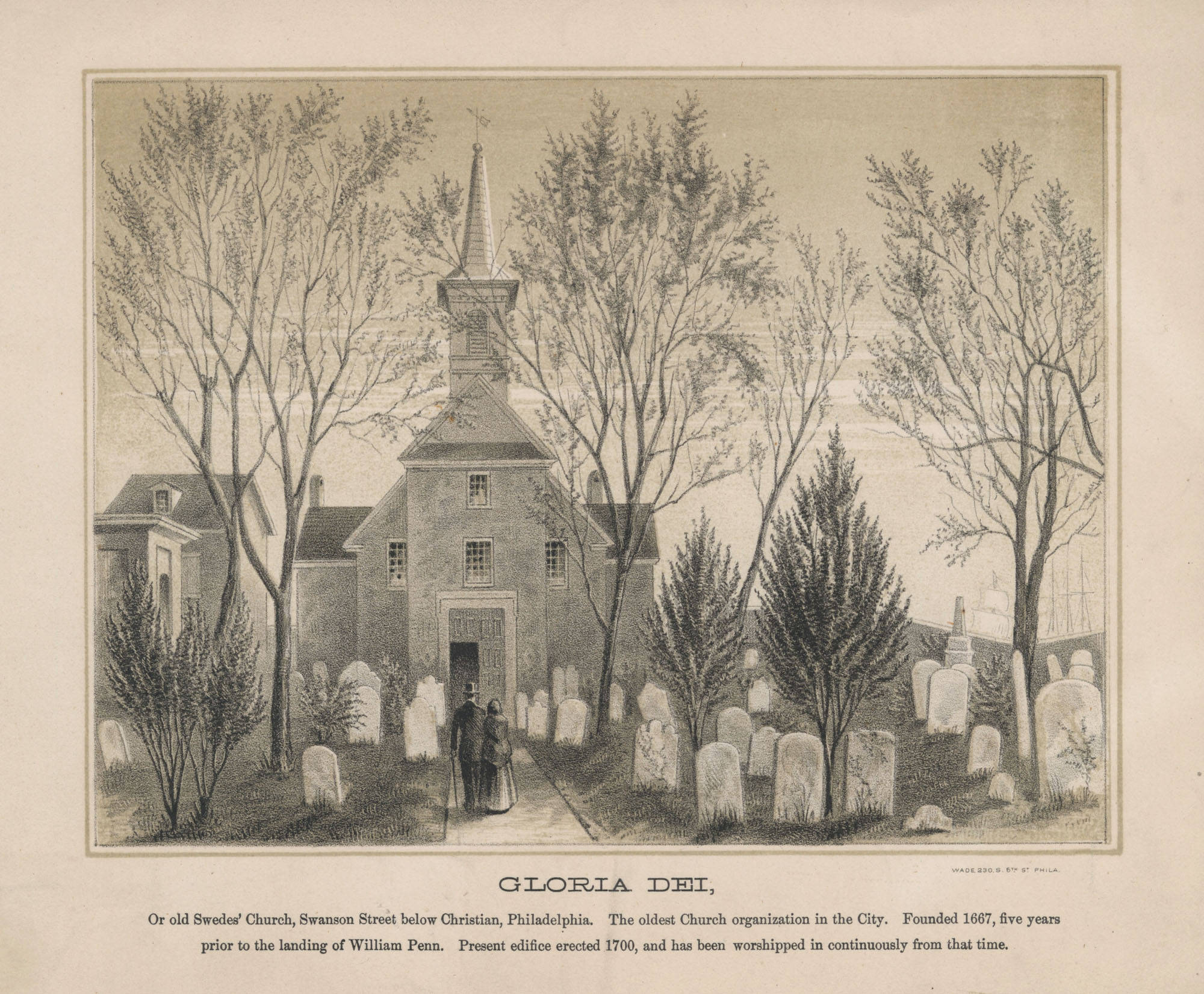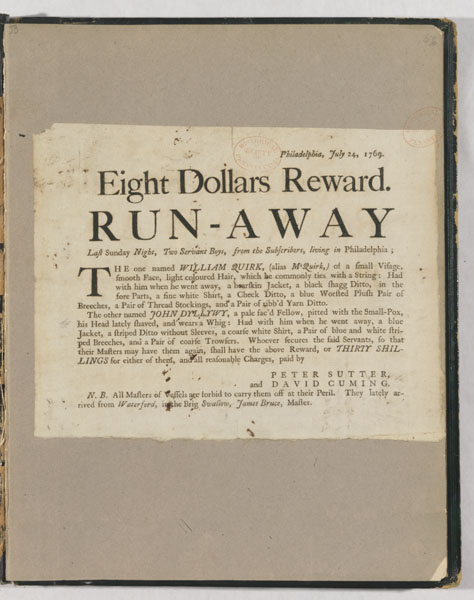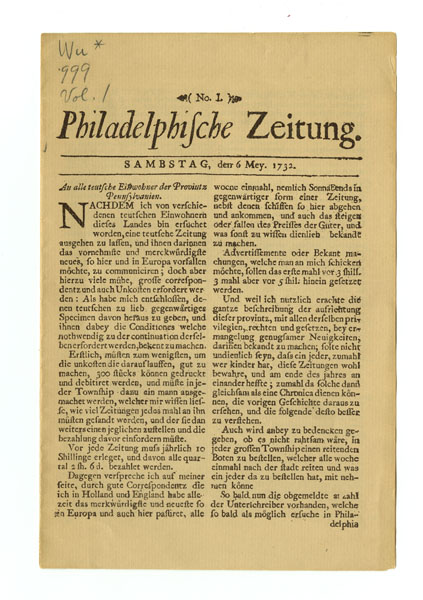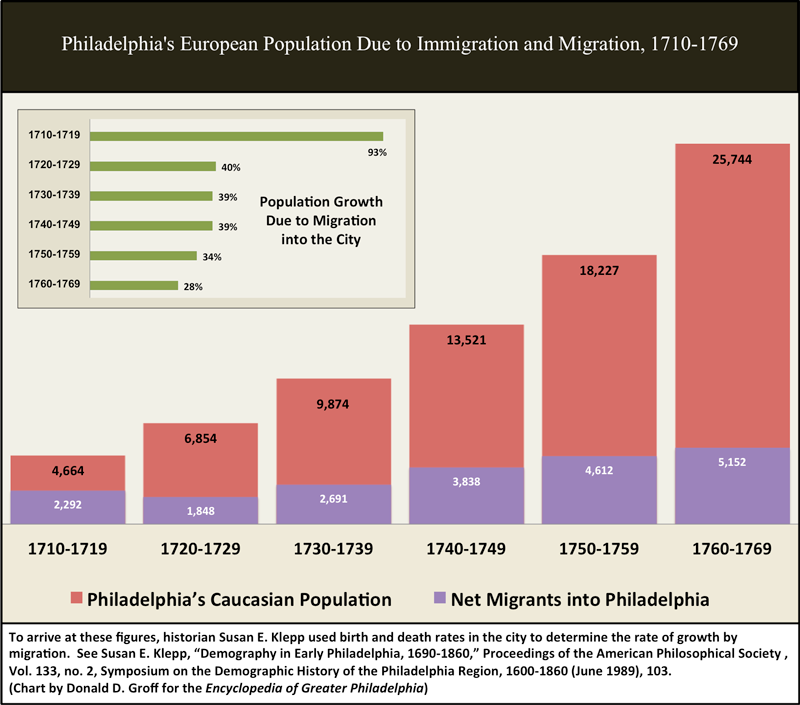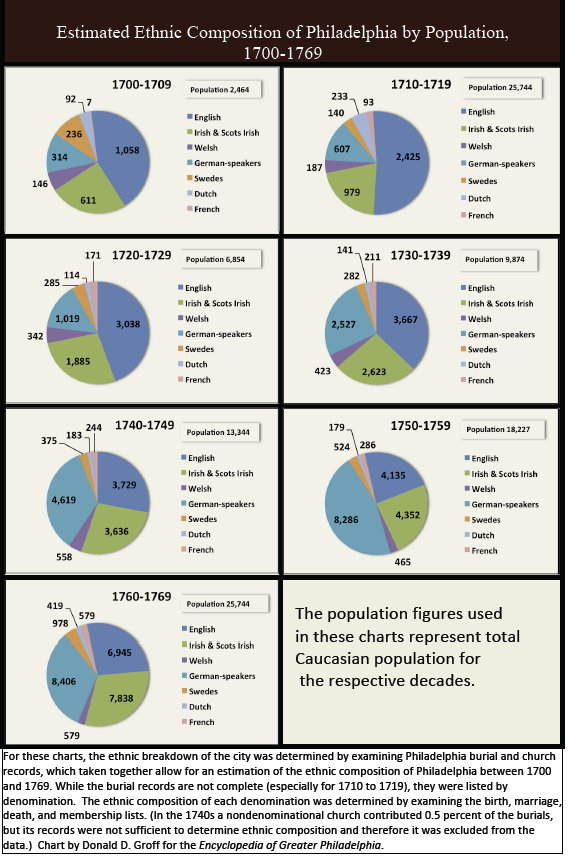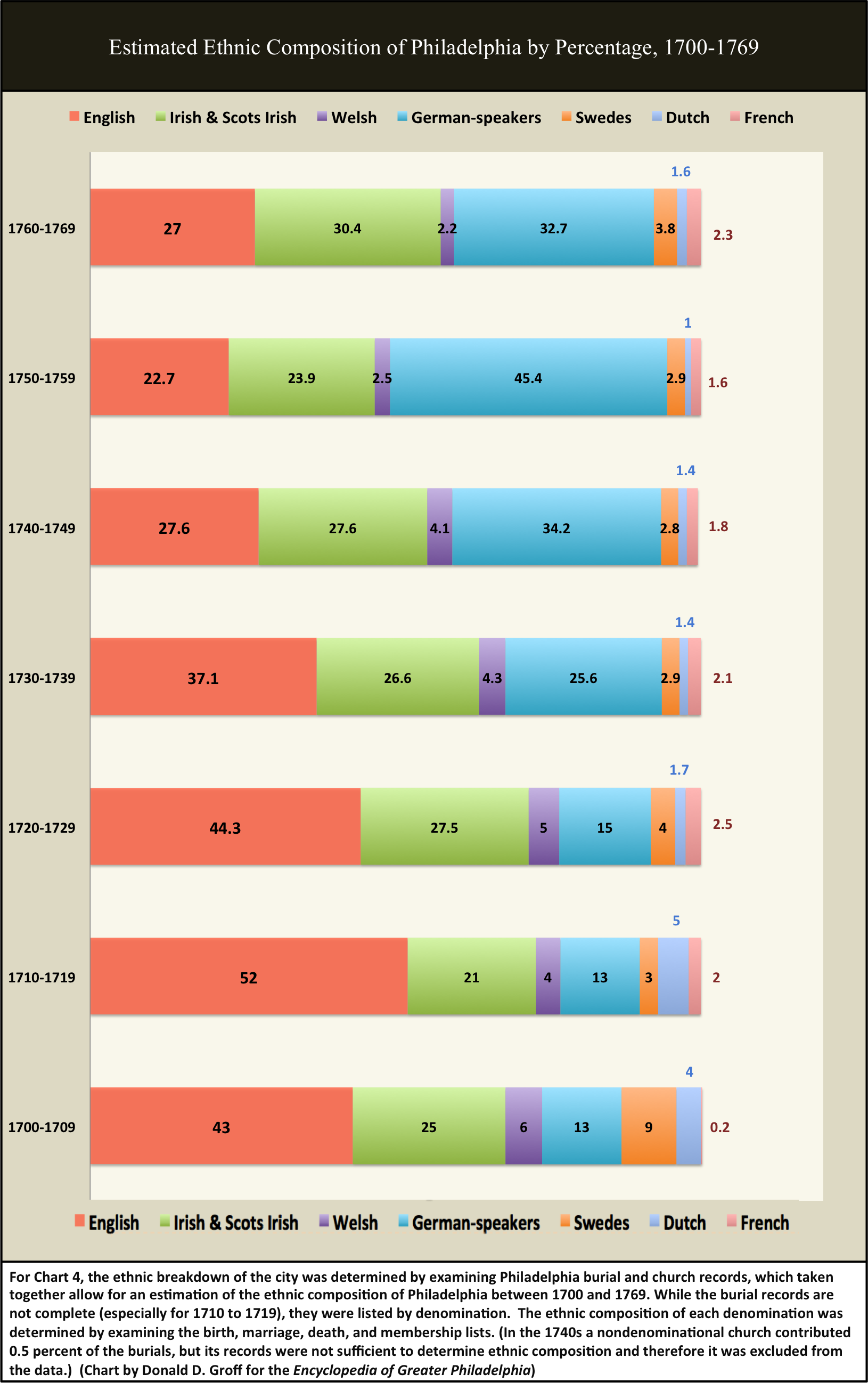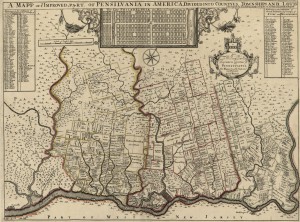Immigration and Migration (Colonial Era)
By Marie Basile McDaniel | Reader-Nominated Topic
Essay
European settlement of the region on both sides of the Delaware River dates to the early seventeenth century. The population grew rapidly after 1682, when Pennsylvania’s policy of religious tolerance and its reputation as the “best poor man’s country” attracted people from all walks of life. By the time of the American Revolution, Philadelphia was the largest city in colonial America. With a population above 32,000, it was noticeably larger than the next two largest cities, New York (25,000) and Boston (16,000). Its size was almost entirely the result of migration from Europe, Africa, and other American colonies.
Settlers—both voluntarily and involuntarily—came to Philadelphia and the surrounding region from England, Wales, Ireland, Scotland, German-speaking lands in the Holy Roman Empire, France, Holland, Spain, Sweden, the west coast of Africa, New York, New Jersey, Massachusetts, Delaware, Maryland, Virginia, and the Caribbean. They were Quakers, Presbyterians, Lutherans, German Reformed, Baptists, Anglicans, Catholics, Jews, possibly some Muslims, and others from a variety of smaller religious sects. Some were wealthy, many more arrived as artisans, laborers, small farmers, or servants hoping to make their fortunes, and many came unwillingly as enslaved Africans. Philadelphia even had its share of pirates (of which very little is known).
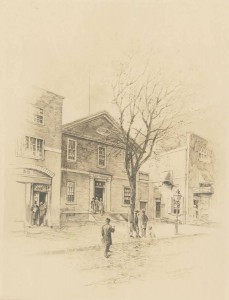
(Library Company of Philadelphia)
In many ways the founder of Pennsylvania, William Penn (1644-1718), designed the province to be socially and economically diverse. He envisioned a utopian society, one in which differences of opinion and backgrounds would naturally create a stable and tolerant society. In his 1670 “The Great Case of Liberty of Conscience,” Penn articulated these beliefs on the necessity of a religiously tolerant society. A few years later, in 1675, Penn noted in his “England’s Present Interest Considered” that the suppression of religious dissent created disorder, while religious diversity and freedom enabled a more ordered, peaceful society. To that end Penn invited persecuted religious groups from other nations to settle in Pennsylvania. He made voyages to continental Europe in 1671, 1677, and 1686 in part to recruit settlers. He wrote four works specifically intended for Dutch and Germans that were later translated and circulated. Penn recruited the mistreated to Pennsylvania to ensure a wide range of religious and ethnic interests to meet his societal goals.
Pre-Penn, a Stable European Population
By the time of Penn’s arrival in Pennsylvania in 1682, the inhabitants included Native Americans as well as some 600 Swedes, Finns, Dutch, and Germans—including some who had settled as early as 1638, when the west side of the Delaware River belonged to New Sweden. When New Sweden became incorporated into New Amsterdam in 1655, the number of Dutch increased. The European population then remained stable and its relations with Native Americans limited until Penn received his charter for Pennsylvania in 1681. Seventeen years earlier, the Duke of York gave the east side of the Delaware River (what is now New Jersey) to Lord Berkeley (1602-78) and Sir George Carteret (1610-80); the former sold his plot to Quaker John Fenwick (1618-83). In the late 1670s under Penn’s guidance, more than 1,000 Quakers from London, Kent, and Yorkshire settled West New Jersey and established towns in Salem and Burlington.
Penn arrived on the ship Welcome on October 27, 1682, with about 100 other Quakers. On the west side of the Delaware they joined another 100 recently settled Quakers who had established two meetinghouses near what would be Philadelphia. These Quakers were of English, Welsh, Irish, and German descent and quickly took over the establishment of government in the new Pennsylvania. In addition, Penn sold plots of land to wealthy Quaker investors, mostly of English descent. A few Welsh Quakers bought 40,000 acres of land on the other side of the Schuylkill River, historically known as the “Welsh Tract,” and established the towns of Haverford, Merion, and Radnor. Other Quakers established the towns of Darby, Chichester, and Concord west of the city, all in the early 1680s. Penn also authorized the naturalization of the preexisting Dutch, Swede, and Finnish inhabitants, some of whom took him up on the offer.
In the first decades under Quaker leadership, Philadelphia became a major port city and a booming trade center, which encouraged migration by merchants and tradesmen coming from England and Wales. By 1700, central Philadelphia grew from a small collection of Swedish homesteads to a population of approximately 2,000 concentrated in a half-mile wide stretch along the Delaware River that extended four blocks inland. Pennsylvania as a whole grew from 680 to nearly 18,000 European residents; New Jersey grew from 1,000 to 14,000 Europeans; and the lower counties on the Delaware (later the state of Delaware, also controlled by Penn) grew from about 200 to nearly 2,500 Europeans by 1700. As trade increased, skilled craftsmen, mostly Quakers, migrated to Philadelphia to do the work of construction, ship building, masonry, carpentry and other service needs of the growing city. Opportunity also attracted farmers, weavers, and millers, who moved to the available hinterland.
Prospects for Progress Drew the Poor
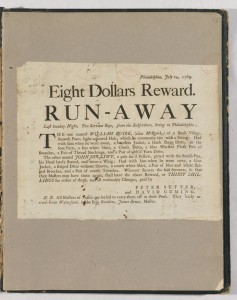
The mercantile possibilities of Philadelphia attracted poor, single young men and some women in search of their fortunes. These redemptioners signed contracts for between one and four years of service in exchange for their voyages. Even more signed indentured-servant contracts, which bound them to up to seven years of service. Some arrived with their masters as part of the family. If they served out their term, they gained fifty acres of land, some tools, and another set of clothing. However, as historian Sharon Salinger noted, four men migrated for every woman, leading to a very uneven gender ratio in seventeenth-century Pennsylvania.
Philadelphia’s demographics changed drastically in the first half of the eighteenth century. Immigrants from western Europe arrived in search of land and religious freedom. Migrants from other colonies came in search of greater, or perhaps just the next, opportunities. Philadelphia experienced exponential growth through the influx of thousands of Germans, Scots Irish, English, and hundreds of enslaved and some free Africans. In 1710, at the start of the influx, Philadelphia contained 2,684 residents. By 1740 that number more than tripled to 10,117, and by 1775 the population tripled again to 32,073. As historical demographer Susan Klepp’s research shows, Philadelphia’s
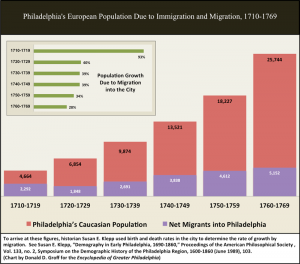
More than 10,000 new settlers arrived annually into the port of Philadelphia. Most moved on to land in Lancaster, York, Berks, and Bucks counties, while only 10 to 20 percent remained
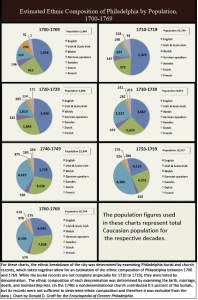
Migration From Colony to Colony
Migration was a part of colonial American life. Eighteenth-century American colonists searched for better opportunities, especially from land-crowded New England and religiously troubled Maryland and Virginia. Benjamin Franklin (1706-90) is possibly the most famous example of such a migrant. Other Americans wandered (mostly walked) into Philadelphia and other parts of Pennsylvania in search of their fortunes. As historian James Lemon noted, nearly half of the population of Philadelphia, and other surrounding towns, migrated every ten years. Of those migrant Philadelphians whose origins in North America (including English Caribbean colonies) have been firmly established between 1700 and 1740, approximately 17 percent originally arrived in Maryland, 17 percent in Virginia, 11 percent in New York or New Jersey, 17 percent in New England, and 38 percent in the Caribbean. Although migrants often moved several times in their lives, records rarely exist for those multiple transitions. The brief appearances of migrants in the records reveal a general migration towards cities, then continually westward.
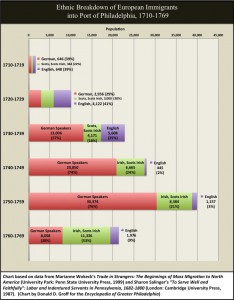
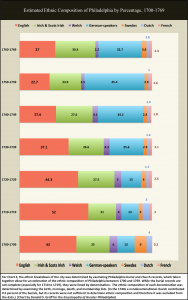
Most migrants traveled to Pennsylvania during periods of European crises. The biggest migration years—1709, 1717, 1727, 1738, and 1749—related to external events. For instance, as historian Marianne Wokeck noted, the end of the War of Austrian Succession in 1749 correlated with a sharp increase in migration from the regions affected by the war. Further, Pennsylvanian booster literature encouraged German-speaking religious groups to migrate. These promoters emphasized material advancement and a ready welcome to migrants.
Immigrants Arrived as Family Groups
During the 1710s through the 1730s, immigrants sometimes traveled in family groups, or followed earlier arrivals and settled with them to get help in establishing households in the new colony. Wokeck noted that at least 35 percent of German-speaking migrants traveled in family groups. This chain migration revealed the strong desire of colonists to draw in others from Europe. The immigrants relied on these contacts to pay for their ship passage. In a process called redemption, they signed contracts for ship passage in exchange for either labor or payment at the end of the voyage. They hoped a friend or kin would pay for the voyage upon their arrival. Germans often redeemed other German-speaking migrants, even strangers.
Despite the prosperity that migrants brought to Pennsylvania, Philadelphians, especially those in positions of wealth and authority, distrusted these new, non-English, arrivals. In 1717, Governor William Keith (1669-1749) recommended to the Provincial Assembly to not “lose any Time in securing yourselves, and all the People of this colony, from the inconveniences which may possibly arise by the unlimited Number of Foreigners that… have been transported hither of late.” The governor believed that migrants would cause harm to Philadelphians. In 1718, James Logan (1674-1751) resolved that “we are resolved to receive no more of them.” In 1727, the Pennsylvania Assembly asserted that “the great Importation of Foreigners into this Province… who are subjects of a foreign Prince, and who keep up amongst themselves a different Language, may, in Time, prove of dangerous Consequence to the Peace.” To the Assembly, foreign migrants were not symbols of a prosperous economy, but a danger. The Provincial Council tried to assuage elite fears by controlling migration. In 1717, the Provincial Council imposed a tax on all incoming Palatines. In 1718, the Provincial Council requested that ship merchants list their passengers, and that all foreigners swear an oath to the King—a requirement not always faithfully observed. These two acts did not curtail migration from Europe.
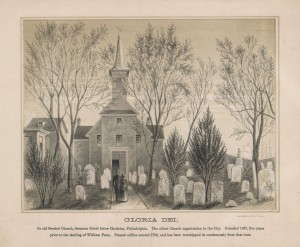
The other major migrant groups to settle in Philadelphia after 1710 came from Ireland. Historians and demographers commonly identify them as “Irish.” Although most Irish migrants were Presbyterian, they also included Anglicans, Baptists, Quakers, and Catholics. Those from Northern Ireland were Scottish Presbyterian transplants to Ireland labeled “Scots Irish” or “Ulster Scots.” Those from southern Ireland were mostly Catholic and labeled simply “Irish.” Altogether, approximately 7,500 Scots Irish and Irish migrants arrived in Pennsylvania before 1740; about 20,000 in the American colonies. Only about 20 percent of these migrants resided in Philadelphia. The rest continued to rural Pennsylvania, founding the town of Carlisle, for instance, in the 1750s. Between 1710 and 1740, Philadelphia’s Irish and Scots Irish population grew from 600 to over 2,600 residents, consisting of between 20 and 27 percent of the total population (see Chart 2 and Chart 4). As historian Patrick Griffin noted, this population grew so much because Scots Irish and Irish migrants reported cheap, plentiful, and bountiful land to their friends and family in Ireland. It was also desirable because Pennsylvania lay on a major trade route, needed weavers and linen workers, and housed the only Presbytery in North America.
Migrants as Buffers
Elite Pennsylvanians initially welcomed Scots Irish and Irish migrants in the hope that they would move to the countryside, creating a buffer between Native Americans and the already settled Pennsylvanians. However, they also worried that Irish and Scots Irish behavior could destroy peaceable relations with the Delaware Indians. In the city, elites blamed recent Irish and Scots Irish migrants for drunken disorderliness.
Surprisingly, little is known about eighteenth-century English migration into Pennsylvania. Nearly 14,000 English migrants sailed into the port of Philadelphia (see Chart 3). Unlike the German, Irish, or Scots Irish migrants, English arrivals did not concern Pennsylvania’s residents. No one complained of an indentured servant or a recent migrant as English. On the other hand, no one extolled the virtues of English migrants, either. One third of these London-embarked migrants traveled as indentured servants. Most of the travelers, servants or not, did not originate from London, but from the far-flung countryside, many from Wales and the north of England, constantly looking for new opportunities.
Nearly 2,700 African slaves arrived in the port of Philadelphia by the eve of the American Revolution. Quakers eagerly bought the first group of slaves directly from Africa in 1684, totaling nearly 150 souls for clearing and building the city. By 1705, nearly 7 percent of families owned slaves. Many of the early slaves (apart from the first 150) arrived from the Caribbean, but by mid-century they increasingly arrived straight from Africa. Most slaves arrived in Philadelphia in two peak periods, from 1732 to 1741 when 510 slaves arrived, and from 1757 to 1766, when 1,290 slaves arrived. Slave importations increased when arrivals of indentured servants decreased and vice versa. As historians Gary Nash and Jean Soderlund have shown, the strength of European indentured servitude in the eighteenth century slowly eroded the importance of slave importation; in 1710, slaves constituted 10 percent of the population, but only 3 percent by the time of the Revolution. Throughout, this Philadelphian slave population depended on slave importations to reproduce. Philadelphians of all socioeconomic levels bought slaves, and two-thirds of Pennsylvania slaves lived and worked within the city. In the twenty years before the Revolution, slaves constituted between two- thirds and three-fourths of unfree labor in the city. Philadelphians bought slaves to help in the household, but also as help in crafts and aboard maritime ships. The few slaves outside of Philadelphia were often bought as status symbols for a country estate. Rarely did farmers use slave labor, preferring to use European servants.
By the time of the Revolution, Philadelphia and the surrounding counties, Berks, Bucks, Cumberland, York, and parts of New Jersey, were ethnically, religiously, and economically diverse. But they were also continually changing. Migrants moved constantly in search of greater opportunities (the reasons they arrived in Philadelphia to begin with). This movement, despite the fears of some settlers, created an environment of acceptance. While no one would call it a pluralistic society (because the term was not common), people of multiple ethnicities and religions lived as neighbors with very few conflicts, and enjoyed relative peace and prosperity.
Marie Basile McDaniel is an Assistant Professor of History at Southern Connecticut State University. This essay is based partly on her work for her dissertation, “We Shall Not Differ in Heaven: Marriage, Order and Identity in Eighteenth-Century Philadelphia.” (Author information current at time of publication.)
Continue to Immigration (1790-1860)
Copyright 2014, Rutgers University

